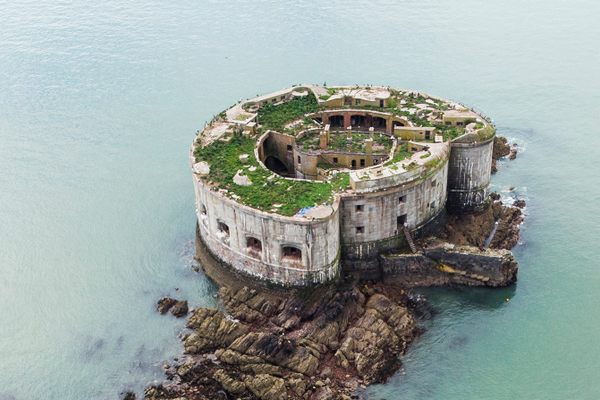Diving Into Estonia’s Abandoned Underwater Prison
A former Soviet labor camp is now partially flooded, like an island in the middle of a lake.
There’s a lot to think about before you dive the sunken ruins of a prison, especially during winter. But the Finnish urban explorers Tanja Palmunen and Kimmo Parhiala thrive on such logistics. Known together as Abandoned Nordic, for the past two and a half years they’ve been traveling across Northern Europe to find and photograph abandoned manor houses, car lots, casinos, churches, and, in this case, an underwater prison, often in the dead of winter.
At Estonia’s Rummu Prison, situated in the middle of a submerged quarry, depth is less of an issue than temperature. “The Rummu lake is a shallow lake, and the average dive depth is around 6 to 10 meters. This means that we can stay down longer without worrying about decompression sickness,” says Parhiala. The greater risk is from diving during the icy winter months. “Northern European winter drops the water temperature to around 3 to 4 degrees Celsius. In these temperatures, we use a drysuit. Still, after a while, our bodies can’t cope with the cold water and we start to feel cold, really cold.”
Another factor is visibility, and at Rummu, there’s a lot to see. The prison—originally known as Murru—was established in the late 1930s, although the first prison cell wasn’t constructed until 1949. Of course, it wasn’t meant to be in the middle of a lake: the location was at a limestone quarry, where inmates were forced to work. Following the collapse of the USSR, the entire sire was abandoned. Groundwater, which was previously pumped into a nearby town and used in local farms, soon flooded the quarry, creating a partially submerged island of crumbling brick walls.

For their dive, the visibility was good, but Palmunen and Parhiala found the water to be what you might expect from an Estonian winter. “The cold shivered my lips when we began our descent toward the underwater parts of the main building,” recalls Parhiala. Diving into submerged buildings in a shallow lake was particularly tricky for the photographer. “You have to adjust the camera settings and keep your focus on your buoyancy, so you don’t touch the bottom and screw up the visibility, and also that you don’t ascend to the surface.”

Above the water, the walls from the main building are visible. But underneath is a vastly different view. “Next to the main buildings, a diver can visit other buildings, which are completely immersed,” says Parhiala. “These large buildings with many rooms are covered in green moss and debris. In addition, a diver can visit the old underwater walls with lamps still intact. It is an odd sensation to imagine the inmates figuring out if they could climb over the walls. Now, we can just hover over them without any resistance.”
During their dive, the Abandoned Nordic team moved slowly through the prison, pausing for photographs and to consider the site’s history. “Bars in the windows reminded us about the history of the place. Like many other abandoned buildings in Estonia, this one was made out of cheap gray bricks which were laying around everywhere on the bottom. Inside this weird underwater building, we watched our exhale bubbles hit the ceiling and enjoyed a break from the sensation of ordinary gravity.”
AO has a selection of images from Abandoned Nordic’s dive; you can see more of their work on their Instagram.

























Follow us on Twitter to get the latest on the world's hidden wonders.
Like us on Facebook to get the latest on the world's hidden wonders.
Follow us on Twitter Like us on Facebook